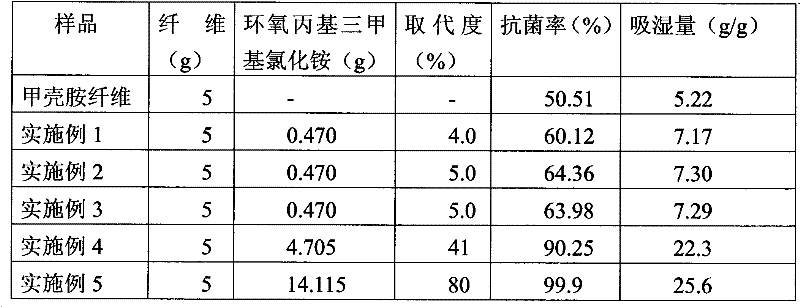Preparation method of hydroxypropyl trimethyl ammonium chloride chitin fiber
A technology of hydroxypropyltrimethylammonium chloride and chitosan fiber, which is applied in fiber treatment, textiles and papermaking, etc., can solve the problems of weakened antibacterial properties of chitosan fiber, reduction of amino content, complex products, etc., to increase poly Cationic properties, simple preparation method, and effect of improving antibacterial properties
- Summary
- Abstract
- Description
- Claims
- Application Information
AI Technical Summary
Problems solved by technology
Method used
Image
Examples
Embodiment 1
[0034] Weigh 5g of chitosan fiber and disperse it in 100mL methanol, add 0.470g of 2,3-epoxypropyltrimethylammonium chloride, shake and stir evenly at room temperature; then add 10.0g of 20wt% NaOH solution at room temperature After stirring uniformly, after reacting in a constant temperature water bath at 50°C for 0.5h, the reacted chitosan fiber and the reaction mixture are separated, and the separated chitosan fiber is dispersed in 80v% methanol aqueous solution, and 15v% is added dropwise Acetic acid aqueous solution, adjust the pH of the methanol and acetic acid aqueous solution mixture to 7.1, soak for 30 minutes, then separate the soaked chitosan fiber from the mixture, wash twice with 80v% methanol aqueous solution, and after dehydration, at 40℃ After drying, a hydroxypropyltrimethylammonium chloride chitosan fiber with a degree of substitution of 4% is obtained.
Embodiment 2
[0036] Weigh 5g of chitosan fiber and disperse it in 100mL of butanol, add 0.470g of 2,3-epoxypropyltrimethylammonium chloride, shake and stir evenly at room temperature; then add 10.0g of 25wt% NaOH solution at room temperature After stirring uniformly, react for 0.5h in a constant temperature water bath at 50℃, separate the reacted chitosan fiber from the reaction mixture, and disperse the separated chitosan fiber in 80v% acetone aqueous solution, and add 15v dropwise % Acetic acid aqueous solution, adjust the pH of the acetone and acetic acid aqueous solution mixture to 6.0, soak for 30 minutes, and then separate the soaked chitosan fiber from the mixture, wash it twice with 80v% acetone aqueous solution, and dehydrate it at 40℃ Drying under the conditions to obtain hydroxypropyltrimethylammonium chloride chitosan fiber with a degree of substitution of 5%.
Embodiment 3
[0038] Weigh 5g of chitosan fiber and disperse it in 100mL of propanol, add 0.470g of 2,3-epoxypropyltrimethylammonium chloride, shake and stir evenly at room temperature; then add 10.0g of 20wt% KOH solution at room temperature After stirring uniformly, react for 0.5h in a constant temperature water bath at 50℃, separate the reacted chitosan fiber and the reaction mixture, and disperse the separated in 80v% ethanol aqueous solution, and dropwise add 15v% acetic acid aqueous solution , Adjust the pH of the ethanol and acetic acid aqueous solution mixture to 8.0, soak for 30 minutes, and then separate the soaked chitosan fiber from the mixture, wash twice with an 80v% ethanol aqueous solution, and then dry at 40°C after dehydration , Get the hydroxypropyl trimethyl ammonium chloride chitosan fiber with a degree of substitution of 5%.
PUM
 Login to View More
Login to View More Abstract
Description
Claims
Application Information
 Login to View More
Login to View More - R&D
- Intellectual Property
- Life Sciences
- Materials
- Tech Scout
- Unparalleled Data Quality
- Higher Quality Content
- 60% Fewer Hallucinations
Browse by: Latest US Patents, China's latest patents, Technical Efficacy Thesaurus, Application Domain, Technology Topic, Popular Technical Reports.
© 2025 PatSnap. All rights reserved.Legal|Privacy policy|Modern Slavery Act Transparency Statement|Sitemap|About US| Contact US: help@patsnap.com

